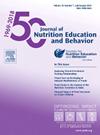故事时间营养:通过讲故事让幼儿参与健康饮食
IF 2.3
3区 医学
Q2 EDUCATION, SCIENTIFIC DISCIPLINES
引用次数: 0
摘要
目的探讨儿童故事书在加强学前和小学儿童营养教育中的创新应用。理论或研究的使用这种方法基于研究表明,将故事书与营养教育相结合可以显著提高儿童的学习能力。故事书使营养概念更加相关和吸引人,帮助孩子理解健康饮食习惯的重要性。研究表明,接触以营养为主题的故事书的孩子更有可能选择更健康的零食,并增加蔬菜摄入量。这种方法不仅促进更好的饮食习惯,而且通过将识字与营养教育相结合,支持认知发展。目标受众学龄前和小学到二年级的儿童。项目描述赫斯基读物是康涅狄格大学开发的营养教育课程,利用几种基于证据的交流形式进行幼儿营养教育,包括故事书和互动运动活动。为了促进儿童早期的健康习惯,FCHS在四个县试点实施了“哈士奇阅读”计划。我们选择了多种多样的故事书,以水果和蔬菜、健康饮食习惯和文化食品为特色,包括西班牙语和双语版本。我们在早教机构、小学、宗教组织、社区中心、图书馆等地开展了讲故事的活动。我们利用视觉辅助、运动活动和口味测试来补充故事书的主题,增加用户粘性。评估方法为了评估项目的有效性,我们从教师和项目协调员那里收集了定性反馈。此外,我们利用定量数据来跟踪进行的会议数量和青年参与者的参与情况。结果通过这一举措,我们成功地扩大了与学龄前和小学儿童的接触和接触。教师和工作人员报告的结果包括新食物的可接受性提高,尝试水果和蔬菜的意愿增加,对“我的餐盘”和基本营养概念的了解增加。通过利用讲故事的力量,这种创新的方法使营养教育对幼儿更有吸引力、更有相关性和更有效。它不仅教授健康饮食的重要课程,还培养了对阅读和文化欣赏的热爱。FundingSNAP-Ed本文章由计算机程序翻译,如有差异,请以英文原文为准。
Storytime Nutrition: Engaging Young Children in Healthy Eating Through Storytelling
Objective
To present the innovative use of children's storybooks to enhance nutrition education for preschool and elementary school children.
Use of Theory or Research
This approach is based on research that indicates pairing storybooks with nutrition education can significantly enhance children's learning. Storybooks make nutrition concepts more relatable and engaging, helping children understand the importance of healthy eating habits. Studies indicate that children exposed to nutrition-themed storybooks are more likely to choose healthier snacks and increase their vegetable intake. This approach not only promotes better eating habits but also supports cognitive development by integrating literacy with nutrition education.
Target Audience
Preschool and elementary school children up to second grade.
Program Description
Husky Reads, a nutrition education curriculum developed by University of Connecticut, utilizes several evidence-based forms of communication for nutrition education in early childhood, including storybooks and interactive movement-based activities. To promote healthy habits in early childhood, FCHS piloted implementation of the Husky Reads program in four counties. We identified a diverse selection of storybooks that feature fruits and vegetables, healthy eating habits, and cultural foods, including Spanish and bilingual editions. We implemented storytelling sessions at early care and education facilities, elementary schools, faith-based organizations, community centers, libraries, and more. We utilized visual aids, movement activities, and taste tests to complement storybook themes and increase engagement.
Evaluation Methods
To assess program effectiveness, we collected qualitative feedback from teachers and site coordinators. Additionally, we utilized quantitative data to track the number of sessions conducted and youth participants engaged.
Results
We successfully expanded our outreach and engagement with preschool and elementary school children through this initiative. Outcomes reported by teachers and staff include improved acceptability of new foods, increased willingness to try fruits and vegetables, and increased knowledge of MyPlate and foundational nutrition concepts.
Conclusions
By leveraging the power of storytelling, this innovative approach makes nutrition education more engaging, relatable, and effective for young children. It not only teaches important lessons about healthy eating but also fosters a love for reading and cultural appreciation.
Funding
SNAP-Ed
求助全文
通过发布文献求助,成功后即可免费获取论文全文。
去求助
来源期刊
CiteScore
4.20
自引率
11.50%
发文量
379
审稿时长
44 days
期刊介绍:
The Journal of Nutrition Education and Behavior (JNEB), the official journal of the Society for Nutrition Education and Behavior, is a refereed, scientific periodical that serves as a global resource for all professionals with an interest in nutrition education; nutrition and physical activity behavior theories and intervention outcomes; complementary and alternative medicine related to nutrition behaviors; food environment; food, nutrition, and physical activity communication strategies including technology; nutrition-related economics; food safety education; and scholarship of learning related to these areas.
The purpose of JNEB is to document and disseminate original research and emerging issues and practices relevant to these areas worldwide. The Journal of Nutrition Education and Behavior welcomes evidence-based manuscripts that provide new insights and useful findings related to nutrition education research, practice and policy. The content areas of JNEB reflect the diverse interests in nutrition and physical activity related to public health, nutritional sciences, education, behavioral economics, family and consumer sciences, and eHealth, including the interests of community-based nutrition-practitioners. As the Society''s official journal, JNEB also includes policy statements, issue perspectives, position papers, and member communications.

 求助内容:
求助内容: 应助结果提醒方式:
应助结果提醒方式:


